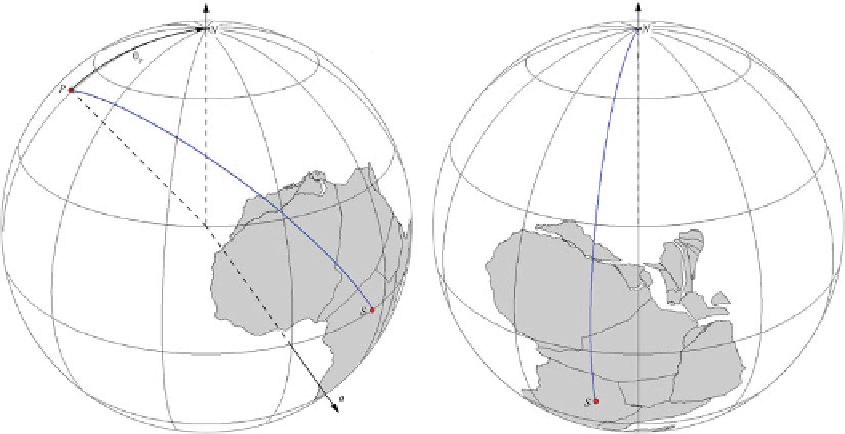Geology Reference
In-Depth Information
Fig. 6.7
Transformation
of
a
paleomagnetic
field
at
an Euler rotation that moves
P
to
N
. In this example, the
Euler axis of rotation,
a
, has pole at (0
ı
,¥
P
C
t
140 Ma (early Cretaceous), with pole at
P
in the
reference frame of Africa (present day coordinates), into
a GAD field. The transformation is performed applying
D
90
ı
)andthe
rotation angle is -™
P
Therefore, solving for ¥
P
gives:
graphic North Pole
N
, as shown in Fig.
6.7
,and
the continent has been restored to its original ori-
entation with respect to the spin axis. However, as
a GAD field is symmetric with respect to the spin
axis, there is no way to establish a paleolongitude
of the site
S
relative to the present day location.
In other words, there are infinitely many rotations
that moves
P
to
N
, which determine infinitely
many longitudinal displacements of the site
S
.All
these reconstructions are admissible, and there
is no way to determine the correct longitude
variation of
S
from the present day location to
its reconstructed position. A common method to
perform paleomagnetic reconstructions is illus-
trated in Fig.
6.7
. In this approach, the paleopole
is moved to the North Pole along its own meridian
of longitude through an Euler rotation about an
equatorial pole at (0,¥
P
C
90
ı
) by an angle -™
P
(e.g., Ziegler et al.
1983
; Schettino and Scotese
2005
). We shall come back to this point in the
next section.
Once that we have determined the paleopole
corresponding to a paleomagnetic direction (
D
,
I
),
the next step is assigning uncertainty parameters
to the location (™
P
,¥
P
). To this purpose, let us
first consider the uncertainty of a paleomagnetic
¥
S
C
“
¥
S
C
“
for cos ™
cos™
P
cos ™
S
for cos ™<cos™
P
cos ™
S
(6.47)
¥
P
D
Differently from a mean paleomagnetic direc-
tion (
D
,
I
), which is a site-dependent quantity,
a paleomagnetic pole of age
t
(the mean age
attributed to the rock unit) is a
global
quantity
that represents the apparent location of the geo-
graphic North Pole at time
t in a reference frame
fixed to the continent to which the site S belongs
(Fig.
6.7
). This is clearly a consequence of the
a time-averaged geomagnetic field approximately
coincides with a GAD field not only in the present
epoch but also in the geologic past. Therefore,
any Euler rotation that brings a paleopole to
the geographic North Pole will also transform
the time-averaged paleomagnetic field associated
with the paleopole into a GAD field. This rotation
coincides with a transformation from a reference
frame where the continent is at rest in the present
day position to a geocentric reference frame in
which the paleopole
P
coincides with the geo-

